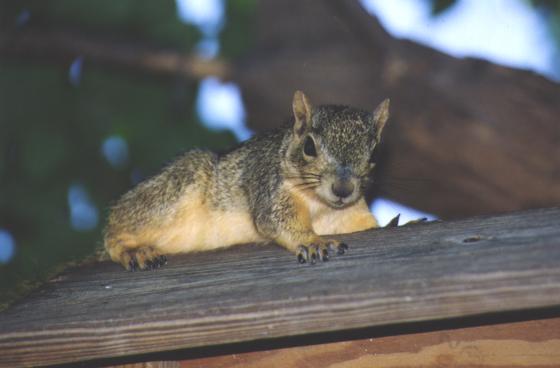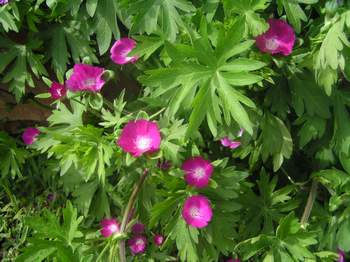|
Creating and maintaining habitat...
Before venturing into the project of designing your own backyard habit it helps to figure out which plants are native to the state you live in. Also, many states are divided into different ecological regions depending on weather, soil type etc. It is no use, for example, putting plants in your Texas back yard that are native to New England. Within a large state such as Texas there are many eco-regions and it is best if you can stick to the plants that belong to that eco-region as much as possible. Again, plants that are native to the humid area of East TX will not be suited to the drier Western desert. You may well live in between two zones and will have no problem growing plants from both.
The reason I feel it is important to stick to this method is because by growing plants native to your eco-region you will then attract the native insects that rely on those plants, which in turn will attract the birds and animals that eat them, and so on up the food chain.
With so many areas being developed and native plants being replaced by exotics it makes it harder and harder for the native wildlife to survive on land that is becoming increasingly fragmented.
Click here to see a list of Plant Species in my garden. This list is always changing. 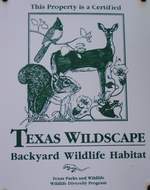 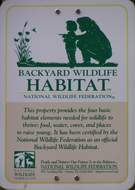
This yard is certified with TP&W as a "Texas Wildscape"
and with the NWF as a "Backyard Wildlife Habitat". When picking out shrubs and plants, although more expensive, I've always tried to get the largest shrub or tree that I can afford at the time. This is just because I like instant gratification! It may take several years for a tree or shrub to grow large enough before it produces fruit so the larger ones just give me a head start. However this is not the most important thing - getting the plants to begin with is the most important step as they will grow in time and secure food and shelter in years to come. If at some point you wish to get your yard certified with the NWF as a Backyard Habitat (as above) or another organization such as TP&W, you do not have to have a finished, mature yard to do so. Just having the plants started and growing with some feeders, a water source and nest boxes supplied will be recognized. Rock and brush piles can be made fairly quickly and can provide instant cover for animals such as toads, lizards, snakes, etc., as well as providing water baths, nest boxes and feeders. All of these can be made quickly and have immediate effects. 
Opossum's come to the feeder and bird bath at night.
Planting for food and shelter -
Use Native plants for your area.
The order in which I did things with my yard of course started with digging some beds. I laid a hose down where I wanted my beds, shaped into gentle curves and then removed the edges first with a shovel. Once this was done I could then remove the rest of the sod. I would stand back and look thinking how much there was to do, looking down the 160 foot yard but just started with a few beds and took my time over several years.
After the sod was all removed the beds were tilled lightly then compost added to bring the level back up. I try to use compost when adding to the beds or containers, as its so rich in nutrients. In some places where the ground did not drain well I added sand. In areas where it was very dry I added a little peat, but prefer to use compost as peat contains no beneficial nutrients for the plants.
SHRUBS -
Once the beds were tilled and filled with good soil/compost I could choose the plants. To begin with I went for as big a plant as could be afforded and in most cases ones which provided berries and or maintained leaves during the winter. This provides shelter for the birds especially in the winter and nesting places in the Spring. Shrubs used included -
Nandinas, Pyrecanthas, Coral berry, American Beautyberry, Yaupon hollies.
These gave the height and structure to the beds. Vines were also added at the backs of the beds against walls and fences as they would then get established over the coming years. These included -
Sweet Autumn Clematis, Lady Banks Rose, Coral Honeysuckle and also a Wisteria just for its beauty! (Caution, needs maintenance.)
PERENIALS -
After shrubs and vines came the Perennials. Perenials are the way to go for a low maintenance yard. Filling in some gaps with annuals is good for adding splashes of color. So in between the shrubs and vines and a little closer to the front of the beds, I planted an assortment of perennials native to this area of Texas and with the tallest towards the back to give a nice layered effect. Perennials included -
Mexican Petunia (be warned, give plenty of space as it will spread) Mexican Marigold, Lantana, Purple Coneflower, Yuccas, Red Yuccas, Lots of Salvias in all colors and varieties, Perennial Verbena, Skullcap and Turks cap.
FILLING IN THE GAPS -
After this, Spring and Summer bulbs were planted in any remaining gaps, under shrubs where their leaves would be hidden during the summer and also in areas where annuals would fill in gaps. By mid summer there is hardly a gap anywhere as each plant grows and blooms to fill its space. I've learnt over the years to give plants plenty of room to grow, planting annuals and bulbs in the bare areas around them until they fill in the space.
GRASS -
Unfortunately this is one thing that is not native in my yard. We use bermuda grass and although it is drought tolerant here, due to keeping the peace at home and in keeping with the neighbourhood we have retained the Bermuda. If I could have my way with this and if our lawn were larger I would pick a more native Texas grass! The maintenance would be much lower and water usage greatly reduced. I strongly recommend this to anyone.
WATERING -
Of course, I do have some plants that are not native but those I do have are drought tolerant and adapted to Texas heat. I only water once every four to five days but water deeply to encourage the roots of all plants and grass to go deeper. If watered frequently and shallowly the roots will always remain towards the surface and will burn much easier when the weather really heats up. Water so the lawn and beds get a good 11/2 inches of water. If watering on a slope or in areas which run-off easily water for half the time then come back around and water again so the soil gets a chance to soak up all the water.
Use Mulch in beds to help retain moisture in the dry months and also to help protect from freeze in the winter. Again, a good layer of compost is a great mulch, or use one of the other popular mulches available such as bark or cedar shavings. Leave leaves on the beds during the winter and leave grass clippings on the lawn.
PESTICIDES -
All I can say here is if you don't eliminate pesticides, or at least reduce them, then you will never be able to see some of the weird and wonderful critters that live in your yard. This also includes weed and feed products as they can have a harmful, toxic if not deadly effect on trees. Instead of using products that fast feed plants for quick results, such as the many types of fertilizers for lawn and plants out there, use natural, slower nutrient releasing matter such as compost, cornmeal, molasses, compost tea, etc., for longer lasting and healthier plants in the long run.
If pesticides are not eliminated then at least use safer versions such as soaps and handmade alternatives. Insecticides do not discriminate, killing beneficial bugs as well as the ones that you're trying to get rid of. They can be deadly to all birds and insects and any other form of wildlife you're attempting to attract to your yard. It also gets more potent as it works up the food chain. I've not sprayed my bushes for 9 years now and I've not lost any to caterpillars. Many species rely on a particular host plant during their caterpillar stage as well as for laying eggs and they have used these plants for thousands of years. Once you find holes in a shrub in most cases the caterpillars are towards the end of that part of their life yet these plants have survived caterpillars and numerous other bugs for eons.
If you wish to remove a problem there are many alternatives to pesticides from organic methods to manual removal of bugs. Please seek out these methods first before reaching for the diazinon. Purchase beneficial bugs such as Lady Bugs (try to get native bugs for your area), beneficial nematodes for the soil and Praying Mantids and place them in your yard.
Click here to visit Pesticide Free - Howard Garrett's Dirt Doctor. for information about the benefits of organic gardening without pesticides and for some great solutions.
You cannot have butterflies if you kill the caterpillars... 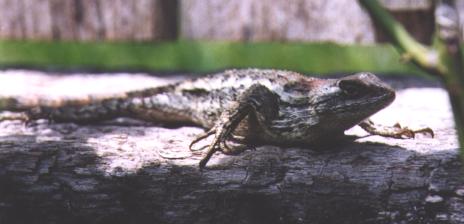
This is "Godzilla"! Not sure if he's still around but he was the largest & I think the oldest lizard in my yard for years. Here, he is approximately 9" long.
WOOD AND ROCK PILES -
Some other things that can be added here and there are rock and log piles. These provide cover for many creatures such as toads and lizards and wood piles provide roosting spots for butterflies. They don't have to be large. I have a few rocks in the yard that have a hollow underneath providing great spots for toads. 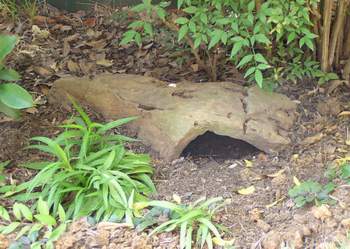
Hollowed out rocks and rock piles provide small animals good places to hide. Brush Piles are also very attractive to birds, being great cover from weather and predators. A good use of your old Christmas tree is to lay it outside during the remaining winter. Birds will be grateful for its evergreen tangle of branches.
Over the years more things have been added to the garden including a deck and a Pond. I love the pond and the wildlife it brings to it. Toads spawn every year, lizards sun on the rocks and birds love the moving water. Last but not least... Several benches were added to the garden so you can sit back and enjoy the habitat created and the wildlife that comes to it :)
Gardening links....
NWF - Turn your backyard into a haven for wildlife
 Holland Wildflower Farm, Online Wildflower Seed Store, AK. Holland Wildflower Farm, Online Wildflower Seed Store, AK.
Daves Garden "For Gardeners... By Gardeners"
NWF & TP&W The Best of Texas backyard Habitats Joint Certification Program
eNature.com Native Gardening and Invasive Plants Guide.
The Nature Conservancy Invasive Plant facts
Weeds Gone Wild A compilation of all the invasive plants throughout the US.
Howard Garrett's Dirt Doctor Garden without pesticides.
Rainbarrelsintl.com Rain Barrels Int - Helping Conserve Our Natural Resources
Texas Rehabilitators Wildlife Rehabilitators by County, TP&W.
Natives of Texas Specializes in Texas native plants, with an emphasis on madrones, a beautiful Texas native tree.
npsot.org Native Plant Society of Texas
seedsource.com Native American Seed
Gardenlifepro.com Pink Muhly Grass - Muhlenbergia Capillaris.
Gardenlifepro.com Deer Grass - Muhlenbergia Rigens.
wildseedfarms.com Wildseed Farms, Fredericksburg, TX.
LBJwildflower.org Lady Bird Johnson Wildflower Center, Austin, TX
Landscapesystems.com Landscape Systems Garden Center, Keller, TX.
Redenta's Garden Native Plants, Dallas & Arlington, TX
thetreeplace.com The Tree Place, Rooted in Fort Worth, TX
Weston Gardens Native plants, Fort Worth, TX
Rohde's Nursery & Nature Store Garland, TX
Stuart Nursery & Landscaping Weatherford, TX
The Victory Garden PBS Programing.
Bringing Nature Home How Native Plants Sustain Wildlife in Our Gardens. A book by Douglas W. Tallamy.
Nurturing Nature A UK Site About Nurturing Nature – Bringing nature into your life
Forward to -
Gardening for Birds - Gardening for Hummingbirds - Gardening for Butterflies
A Garden Pond
© Copyright 2025, All Rights Reserved. 37925
|
|


